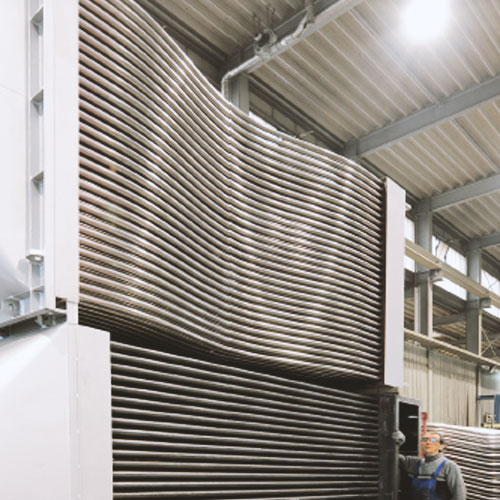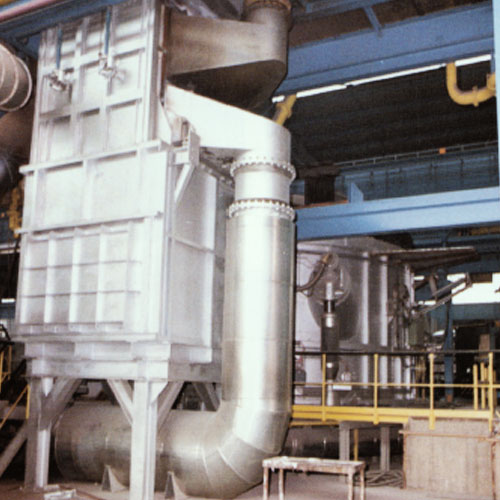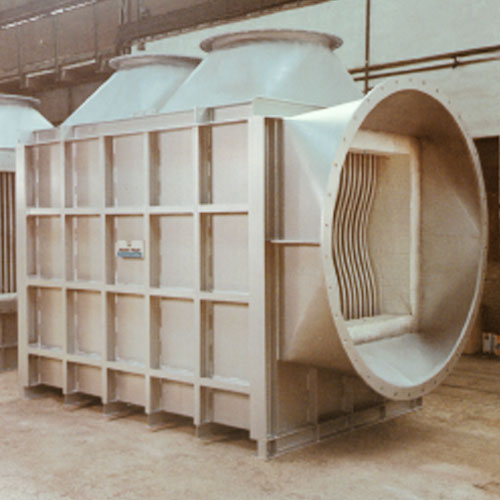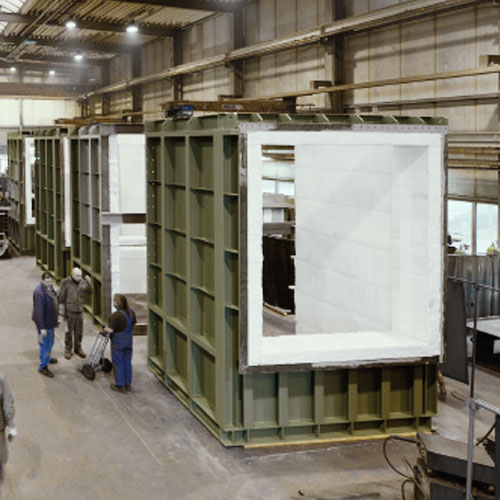
Peiler Recuperators
in Steel Production and Processing

Peiler Recuperators
on Aluminium Melting Furnaces

Peiler Recuperators
on Thermal Post-Combustion Systems

Special Applications
for Peiler Recuperators

Peiler Recuperators
in Steel Production and Processing

Peiler Recuperators
on Aluminium Melting Furnaces

Peiler Recuperators
on Thermal Post-Combustion Systems

Special Applications
for Peiler Recuperators
The trend points downwards: In rolling mills, advanced processes and improved furnace technology ensure falling exhaust gas temperatures. If the waste gases do not contain any corrosive constituents or dust, the Peiler Convection Recuperator is the best choice for heating technology. This is because the lower waste gas temperatures in current normal furnace operations require larger recuperator heating surfaces to ensure economic feasibility. A Peiler Convection Recuperator is also still recommended when using aggressive casting additives due to special protective measures which enable the recuperator to achieve a service life of over five years, even with a total of more than 10 % potassium oxide (K2O) sodium oxide (Na2O). In addition, the fact that groups or bundles of pipes can be easily replaced makes Peiler Convection Recuperators simple to repair.
The use of an exclusive Radiation Recuperator in rolling mills is only justified if high waste gas temperatures, high dust contents and corrosive constituents are present in the waste gas. However, if high waste gas temperatures occur without any aggressive constituents in the waste gas, for example, in specific furnaces (in particular forging and pit furnaces), the use of the Peiler Turbomant type suggests itself.
What is true for the operation of recuperators on forging and pit furnaces applies equally to their use on aluminium melting furnaces. However, here consideration has to be given to the more difficult chemical conditions such as chlorine and fluorine in the waste gases, the use of salt when the slag is being skimmed and the large quantities of dust produced when scrap is melted down. These factors have a negative effect on the performance and durability of the recuperator.
In order to achieve uniformly high heat recovery levels, exclusive Convection Recuperators are successfully used during chlorination in a separate furnace. During this phase the recuperator is bypassed on the flue gas side by means of a bypass system. Periodic cleaning of the heating surfaces during operation helps against dust deposits. In addition, the recuperator can be designed to be retractable and extendable for the purposes of cleaning. In thermotechnical terms the installation of a Convection Recuperator is certainly more expedient than the installation of an exclusive Radiation Recuperator, as economical air preheating temperatures are reached over the entire melting process, while the exclusive Radiation Recuperator achieves the highest air preheating in the throttling range, i.e. when this is of minor significance for the smelting process. The thermotechnical disadvantages can however certainly be ignored if corrosive constituents are present in the waste gas. Under these difficult conditions there is however no alternative to using a Peiler Radiation Recuperator on aluminium melting furnaces.
Thermal post-combustion is a tried and tested and widely used process today for the removal of air impurities from waste gases. With the exception of a few non-hazardous residual components, the waste gases are completely transformed into water and carbon dioxide. In order to minimise the costs for additional fuels, Peiler Convection Recuperators are used for exhaust air preheating.
Consideration of the cost-effectiveness aspects shows that at combustion temperatures of e.g. 800 °C even relatively large exhaust air pre-heaters (exhaust air preheating temperature 500 °C to 600 °C) often pay for themselves within less than two years if the hot clean gases from the combustion chamber flow through the recuperator. But other circuit variations are also cost-effective. This exhaust air pre-heater concept can be used in this way both for new systems and for the modernisation of old systems.
Robust recuperators for the preheating of exhaust air in thermal post-combustion plants
Besides their use in the steel industry and environmental protection, Peiler recuperators have also proven their worth in other applications:
Porcelain, as well as earthenware and stoneware, are fired at high temperatures, with the so-called glost firing of porcelain for example requiring temperatures of up to 1,480 °C – and that for approximately 30 hours. Peiler Radiation Recuperators and the Peiler recuperator type known as the Turbomant can reduce energy consumption con siderably in such cases, i.e. up to 30 % in.
The cremation is carried out in two phases: in the first step in a muffle furnace temperatures of around 900 °C are reached, while in the second step the connection of a gas burner increases the temperature up to 1,200 °C. The second step consumes a great deal of energy, so that here the use of a Peiler recuperator results in significant energy savings.